This system ensures compliance with modern standards for toxicity of emissions and fumes of harmful substances while maintaining high driving performance and low fuel consumption.
The control device in the system is an electronic control unit (ECU, controller). Based on the information received from the sensors, the ECU calculates the parameters for fuel injection control and ignition timing control. In addition, in accordance with the embedded algorithm, the ECU controls the operation of the electric motor of the fan of the engine cooling system and the electromagnetic clutch for turning on the air conditioning compressor, performs the function of self-diagnostics of the system elements and notifies the driver of any malfunctions.
In the event of failure of individual sensors and actuators, the ECU includes emergency modes that ensure engine performance.
The amount of fuel supplied by the injectors is determined by the duration of the electrical signal from the ECU. The electronic unit monitors data on the state of the engine, calculates the need for fuel and determines the required duration of fuel supply by injectors (signal duration). To increase the amount of fuel supplied, the duration of the signal increases, and to reduce the fuel supply, it decreases.
The engine management system, along with the electronic control unit, includes sensors, actuators, connectors and fuses.

Electronic control unit (ECU) is connected by electrical wires to all sensors of the system. Receiving information from them, the block performs calculations in accordance with the parameters and control algorithm stored in the memory of a programmable read-only memory device (PROM), and controls the executive devices of the system. The program variant recorded in the PROM memory is indicated by the number assigned to this ECU modification.
The control unit detects a malfunction, identifies and stores its code, even if the failure is unstable and disappears (e.g. due to poor contact). The signal lamp for a malfunction of the engine management system in the instrument cluster goes out 10 s after the failure of the unit is restored.
After repair, the fault code stored in the memory of the control unit must be erased. To do this, turn off the power supply of the unit for 10 s (remove the fuse for the power supply circuit of the electronic control unit or disconnect the wire from the "minus" terminal of the battery).
The unit supplies 5 and 12 V direct current to various sensors and switches of the control system. Since the electrical resistance of the power circuits is high, the test lamp connected to the system outputs does not light up. To determine the supply voltage at the computer terminals, a voltmeter with an internal resistance of at least 10 MΩ should be used.
The ECU is not repairable and should be replaced if it fails.

The diagnostic connector is used to display fault codes from the ECU memory detected during the operation of the engine management system.
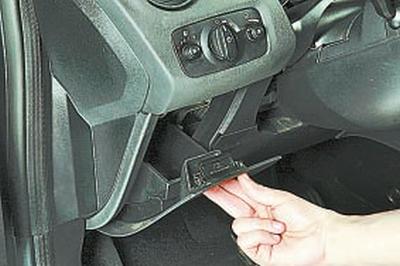
The diagnostic connector is located in the passenger compartment under the instrument panel on the left side (inside the storage box, under the hinged lid). A scan tool can be connected to the diagnostic socket that reads trouble codes.
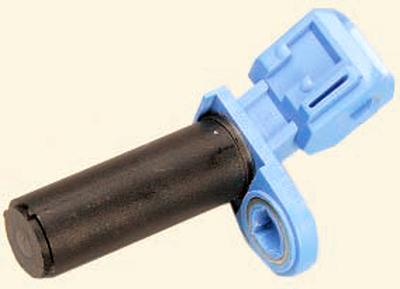
The crankshaft position sensor of the inductive type is designed to synchronize the operation of the electronic control unit with the TDC of the pistons of the 1st and 4th cylinders and the angular position of the crankshaft.
The sensor is mounted at the rear of the engine opposite the master teeth on the flywheel. The master teeth are made on the surface of the flywheel at regular intervals.
One tooth is missing to create a sync pulse ("reference" pulse), which is necessary to coordinate the operation of the control unit with the TDC of the pistons in the 1st and 4th cylinders.
As the crankshaft rotates, the teeth change the sensor's magnetic field, inducing AC voltage pulses. The control unit determines the crankshaft speed from the sensor signals and sends pulses to the injectors.
If the sensor fails, the engine cannot be started.
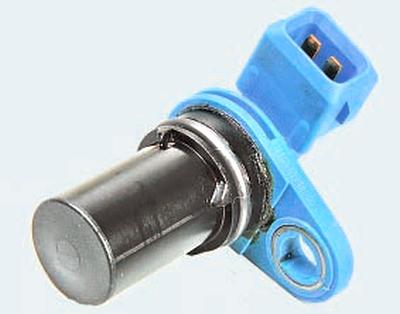
Camshaft Position Sensors (phase sensors) of the inductive type determine the TDC of the compression stroke of the piston of the 1st cylinder and serve to organize phased fuel injection in accordance with the order of operation of the cylinders. For engines equipped with a variable valve timing system, the signals from the intake and exhaust camshaft sensors are also used by the controller to control the change in valve timing depending on the engine operating mode.
If a malfunction occurs in the circuit of any of the sensors, the controller stores its code in its memory and turns on the signal lamp.

The coolant temperature sensor is installed in the coolant distributor housing at the rear of the engine. The sensing element of the sensor is a thermistor, the electrical resistance of which varies inversely with temperature. Low coolant temperature (-40°С) the resistance of the thermistor is about 100 kOhm; when the temperature rises to +130°C, it decreases to 70 Ohm.
The electronic unit feeds the temperature sensor circuit with a constant reference voltage. The sensor signal voltage is maximum on a cold engine and decreases as it warms up. Based on the voltage value, the electronic unit determines the engine temperature and takes it into account when calculating the injection and ignition control parameters.
If the sensor fails or there are violations in its connection circuit, the ECU sets the fault code and remembers it.
In addition to the above, the sensor indirectly also serves as a sensor for the coolant temperature indicator in the instrument cluster. According to information from this sensor, the electronic engine control unit changes the position of the pointer.
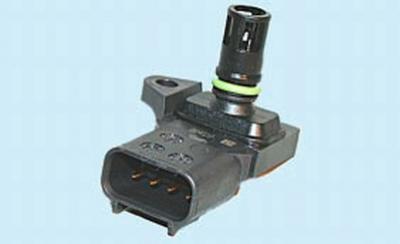
The combined intake manifold absolute pressure and intake air temperature sensor is made in the form of a pressure sensitive variable resistor. It detects changes in intake manifold pressure in response to changes in engine load and RPM. Depending on the information received from the sensor, the ECU registers the amount of fuel injected and the ignition timing.
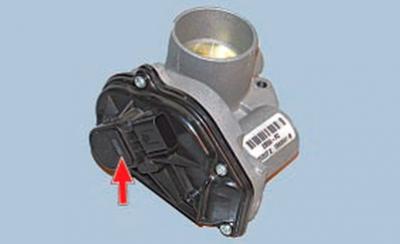
Throttle position sensor is made in one piece with the throttle assembly cover.
The sensor is a potentiometer, one end of which is supplied with a "plus" supply voltage (5 V), and the other end is connected to ground.
From the third output of the potentiometer (from the slider) is the output signal to the electronic control unit.
When the throttle is turned (according to the effect on the accelerator pedal), the voltage at the output of the sensor changes. When the throttle is closed, it is lower than 0.5 V. When the throttle opens, the voltage at the sensor output rises, when the throttle is fully open, it should be more than 4 V.
By monitoring the output voltage of the sensor, the ECU adjusts the fuel supply depending on the throttle opening angle (those. at the request of the driver).
The throttle position sensor does not require adjustment, as the control unit perceives idling (those. full throttle closing) as a zero point.
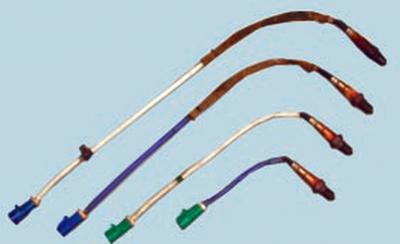
Oxygen sensors (lambda probes) are screwed into the threaded holes of the collector. On Ford Mondeo cars, depending on the type of engine, two or four oxygen concentration sensors are installed:

– one or two sensors for air-fuel mixture control (at the entrance to the neutralizers) …

...and one or two more diagnostic sensors to evaluate the efficiency of the converters (at the exit).
A galvanic cell is located in the metal bulb of the sensor, washed by the flow of exhaust gases. Depending on the oxygen content in the exhaust gases, as a result of the combustion of the air-fuel mixture, the voltage of the sensor signal changes.
Sensors differ in parameters and have different markings. If at least one of the oxygen concentration sensors is faulty, the toxicity of exhaust gases can increase dramatically, and fuel consumption can increase.
For ease of replacement, the sensors differ in the color of the pads. Sensor wiring harness block at the inlet to the converter (manager) - green, and at the outlet of the converter (diagnostic) - purple (or blue).
Information from each sensor enters the control unit in the form of low signals (from 0.1 V) and high (up to 0.9 V) level. With a low level signal, the control unit receives information about the high oxygen content. A high level signal indicates a low oxygen content in the exhaust gases.
Constantly monitoring the voltage of the sensor signal, the control unit adjusts the amount of fuel injected by the injectors. With a low level of the sensor signal at the input to the converter (lean air-fuel mixture) the amount of fuel supplied increases, with a high signal level (rich mixture) - decreases. If the difference between the levels of the sensor signals at the input and output of the converter is less than the values admissible in this mode of operation, the control unit identifies a malfunction of the collector.
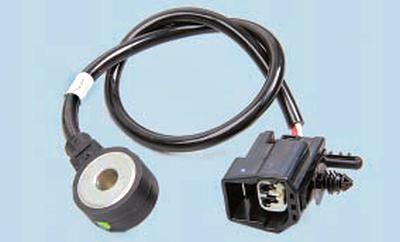
The knock sensor of the Duratec Ti-VCT engine is attached to the top of the cylinder block in the area between the 2nd and 3rd cylinders, and the remaining engines have two sensors in the areas between the 1st and 2nd, and also between the 3rd and 4th cylinders. The sensor picks up abnormal vibrations (detonation strikes) in the engine.
The sensing element of the knock sensor is a piezoelectric plate. During detonation, voltage pulses are generated at the output of the sensor, which increase with increasing intensity of detonation impacts. The ECU, based on the signal from the sensor, regulates the ignition timing to eliminate detonation flashes of fuel.
During operation, the ECU also uses vehicle speed data received from the anti-lock braking system control unit (ABS).
WARNINGS: Disconnect the wire from the battery negative terminal before removing any fuel injection control system components.
Do not start the engine if the cable lugs on the battery are loose.
Never disconnect the battery from the vehicle's electrical system while the engine is running.
When charging the battery, disconnect it from the car's on-board network.
Do not expose the ECU to temperatures above 65°C in working condition and above 80°C in non-working condition (e.g. in a drying chamber).
It is necessary to remove the computer from the car if this temperature is exceeded.
Do not disconnect from the computer or connect wires to it with the ignition on.
Before carrying out electric welding work on the car, disconnect the wires from the battery and the wiring harness pads from the computer.
Make all voltage measurements with a digital voltmeter with an internal resistance of at least 10 MΩ.
Electronic components used in the fuel injection system are designed for very low voltage, so they can be easily damaged by electrostatic discharge.
To prevent damage to the computer, do not touch its terminals with your hands.
In all cases, a special scanner is required to diagnose the engine management system, so if a system malfunction occurs, contact a specialized service.
Visitor comments